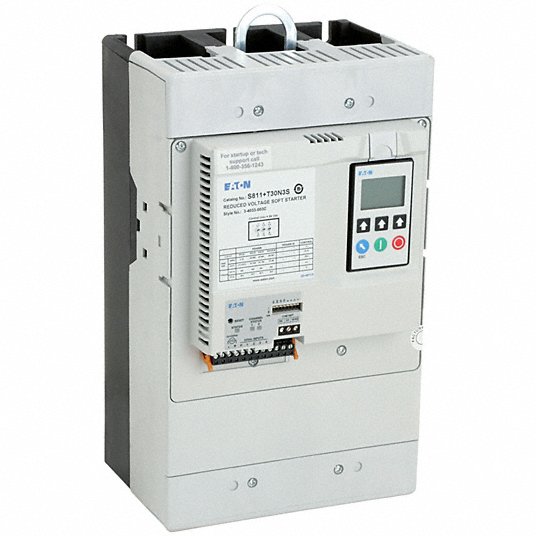
Pump Features for Soft Starts
April 2025 | Soft Starters, Motor Control, Industrial Pumps, Pump Protection, Inrush Current, Water Hammering
In industrial environments, electric motors are the workhorses behind countless applications, including pumps, fans, conveyors, compressors, and mixers. While motors are robust, the starting phase—especially in high-torque, high-inertia operations—can expose the motor and connected equipment to significant electrical and mechanical stress. This is where soft starters come into play, particularly in pump applications where gradual acceleration is critical. This guide explores the benefits, selection criteria, and real-world applications of soft starters in industrial pump systems.
What Is a Soft Starter?
A soft starter is a solid-state motor control device that limits the inrush current and torque applied to the motor during startup. Unlike Direct-On-Line (DOL) starters that apply full voltage instantly—leading to high current spikes and mechanical shocks—soft starters gradually ramp up voltage, allowing the motor to smoothly reach its operating speed.
Most soft starters operate using back-to-back Silicon Controlled Rectifiers (SCRs) or TRIACs. These components regulate voltage by adjusting the timing of gate pulses, effectively managing how much power reaches the motor over time. This controlled ramping reduces wear, prolongs motor life, and improves overall system reliability.
Why Soft Starters Are Ideal for Pumps
Pumps represent approximately 40% of motor-driven applications in industrial facilities. In these systems, sudden startups and stops can lead to problems such as water hammering, pipe stress, and high maintenance costs. Here's how soft starters help:
1. Reduced Risk of Water Hammering
Soft starters prevent abrupt starts and stops, minimizing pressure surges within pipelines. This protects both the piping system and the pump from damage caused by sudden hydraulic shocks.
2. Inrush Current Reduction
Soft starters can reduce inrush current by up to 40%, safeguarding electrical components and infrastructure while also conserving energy during motor startup.
3. Smooth Operation and Extended Equipment Life
Soft acceleration reduces the mechanical strain on couplings, seals, bearings, and impellers, extending the life of the motor and pump.
4. Intelligent Pump Control Features
Modern soft starters offer advanced protection features including:
-
Underload protection (dry-run detection)
-
Phase reversal and phase loss detection
-
Over-voltage and over-current safeguards
-
Bypass contactors for efficiency after ramp-up
Choosing the Right Soft Starter for Pump Applications
1. Understand the Application Load
Pumps have varying torque and starting characteristics. For centrifugal pumps, torque increases with speed, whereas for positive displacement pumps, starting torque may be constant or variable. Select a soft starter that aligns with these dynamics.
2. Verify Safety & Monitoring Features
Ensure the soft starter includes:
-
Real-time diagnostics
-
Fault alarms
-
Thermal overload protection
-
Enclosure ratings suitable for the environment (e.g., NEMA 4X, IP65)
3. Pump Control Functions
Look for pump-specific features such as torque control and ramp-down time adjustments, which are essential to eliminate water hammering and ensure smooth shutdown.
4. Frequency of Starts/Stops
Some pumps cycle frequently. Make sure the soft starter supports the required number of starts per hour to avoid overheating or premature failure.
Soft Starter vs. Variable Frequency Drive (VFD)
While both soft starters and VFDs are used to manage motor behavior, they serve different needs:
| Feature | Soft Starter | VFD |
|---|---|---|
| Starting Method | Gradual voltage increase | Frequency-controlled startup |
| Speed Control | No | Yes |
| Energy Savings | During startup only | Continuous (up to 50%) |
| Cost | Lower | Higher |
| Footprint | Compact | Larger |
| Ideal For | Pumps, fans, conveyors | Systems requiring variable speed |
Soft starters are ideal when smooth acceleration and torque control are needed, and speed variation is not a requirement.
Real-World Pump Applications
Centrifugal Pumps
Used for water distribution, irrigation, and industrial fluid movement. Soft starters prevent rapid torque spikes and reduce water hammering.
Submersible Pumps
Found in sewage and dewatering systems. Soft start protects against seal damage and impeller stress.
Positive Displacement Pumps
Ideal for viscous fluids and dosing systems. A soft starter prevents sudden pressure build-up, protecting piping and process integrity.
Booster Pumps
Used in HVAC and municipal systems. Soft starters provide consistent ramp-up and ramp-down, ensuring no pressure surges in the system.
Final Thoughts
Soft starters are essential tools for pump applications that prioritize system protection, energy efficiency, and long-term reliability. They eliminate the need for expensive mechanical solutions like fluid couplings and significantly reduce maintenance costs associated with mechanical wear and electrical stress.
If you’re integrating a new pump system or upgrading an existing one, choosing a soft starter tailored to your operational needs could be one of the most cost-effective and impactful decisions you make.
Need help selecting the right soft starter for your pump?
Contact PLG Automation at sales@plgautomation.com or call 800-906-9271. We’ll help you find the best solution tailored to your specific application and system requirements.
